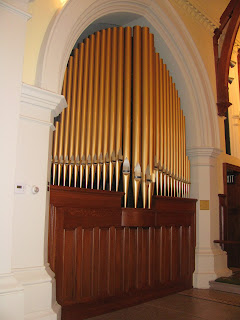Click on any picture to view it full size; use the ESC key or back arrow to return to this page.
IN SEARCH OF MORSE,
WALLANDER & TUTANKHAMUN
Carol Dennis
It started as a mystery.
How could we stay in Oxford, England, so that we could tour the city and
follow in the footsteps of Chief Inspector Morse (or Lewis and Hathaway)? Jerry’s conference was taking him to Didcot,
England, near Oxford.
Ten years ago, when
we last traveled to Didcot, the accompanying ladies had a bit of trouble being
able to spend time in Oxford. This time we
all decided to stay near the center of Oxford and let the gentlemen drive or
take the bus to their conference.
including his favorite Turf
Pub, down a narrow alley,
plus the Ashmolean Museum,
the Bodleian Library, the Bridge
of Sighs, and Christ Church Cathedral where John and Charles Wesley studied and
were ordained.
Its dining hall is now
famous for being featured in the Harry Potter movies. While at the cathedral,
an organist came to practice on the new Rieger that is behind the traditional
façade. I learned from a friendly verger
that a visiting choir was coming that day for Evensong, but the other ladies
were ready to move on to our next adventure, so I was unable to stay and listen
for very long.
On Sunday, Jerry and I attended a Solemn Mass (think Latin)
with mixed choir and pipe organ at The Oratory, a landmark church in Oxford
also known as the Catholic Church of St. Aloysius Gonzaga. The music listed was the Mass: Queen of the Holy Rosary by Georg Amft, Ave Maria gratia plena by Friedrich Himmel and Salve Regina by Josef Rheinberger. No organist (who was quite good) or
prelude/postlude music was listed. The
church was fairly full, and the Latin responses strong. There was plenty of incense, three priests in
traditional chasubles, and a deacon. It
certainly was a trip down memory lane for us old timers!
One day, my friend and I lunched at the Eagle and Child Pub
(frequented by C. S. Lewis, J. R. R. Tolkein and the other Inklings
who called it the Bird and Baby).
Oxford is extremely cosmopolitan with a multitude of languages being
spoken. The biggest surprise was the delicious food everywhere we went.
Another day, we ladies took a double-decker bus to Blenheim
Palace, an enormous edifice built to honor the victory in 1704 of the first Duke
of Marlboro at the Battle of Blenheim, Germany.
It’s most important claim to fame today is that it is the birthplace of
Winston Churchill. In its great hall stands
a four-manual concert organ built in 1891 by Fr. Willis. It is still used for recitals and special
events but is in great need of refurbishing according to the Organ Appeal
brochure.
Following the week’s conference, Jerry and I flew to
Copenhagen, Denmark. Our son, John, and
his lovely wife, Anna, met us and drove across the Oresund Bridge to Malmoe,
Sweden. Saturday was a pleasantly quiet
day with dinner at their home consisting of warm-smoked salmon and several
kinds of herring – a splendid Swedish meal topped by a cobbler made from their
garden apples by our granddaughter, Julia.
The next day, we drove to Ystad, a charming town on the south-east coast
of Sweden made famous by the stories of Detective Kurt Wallander.
The tourist office was closed (after all, it was
Sunday), but we were able to lunch at Fridolfs Konditori,
Wallander’s favorite café and pastry shop.
We strolled the old town, Gamla Staden, and
visited St. Maria Church. There are three pipe organs in the church –
one in
the christening chapel,
one in the side nave for accompanying the congregation
and one with a splendid facade in the organ loft. A group of young Salvation Army musicians
were rehearsing for that evening’s concert when we stopped by, so there were no
organs to be heard. We then drove to
Kivik, another Wallander site, where an apple festival would be held the
following week.
We bought mulled cider
at the Cider House and visited its very Swedish café.
On Monday, John took us to the international Tutankhamun
exhibit.
We had seen another King Tut
show in D.C. back in the 1970s when John was small and raced through as fast as
he could. Now, he would be bringing a
group of his own students, and he was most interested, especially in how to
present it to a group of middle-school kids.
How times have changed! The show
was very well presented. As we strolled through,
each section was highlighted as headphones in English described the drama of
finding and excavating the tomb. That evening, Anna served a traditional meal
of roasted sliced reindeer and potatoes with her delicious berry tart for
dessert.
On our last day, we had planned to meet with the students to
talk about life in America and let them practice their English. However, on the weekend there had been a
burglary at the school. Needless to say,
that caused upset and confusion for the students as well as extra stress for
the teachers. So instead, Jerry and I
visited the Malmoe Museum of Modern Art.
The show was Surrealism featuring Arcimboldo,
(famous for his paintings of faces made from fruits and vegetables), Magritte,
Dali and Miro and then contemporary photos and paintings.
A little shopping was needed after that to
regain our equilibrium! That evening we
all dined with Anna’s father, Olle, who regaled us with stories of “the old
days.”
The next day Jerry and I returned home from another exciting
trip. At that point, we were more than ready
to just tune in our favorite mystery shows from the comfort of our own
recliners.




















































